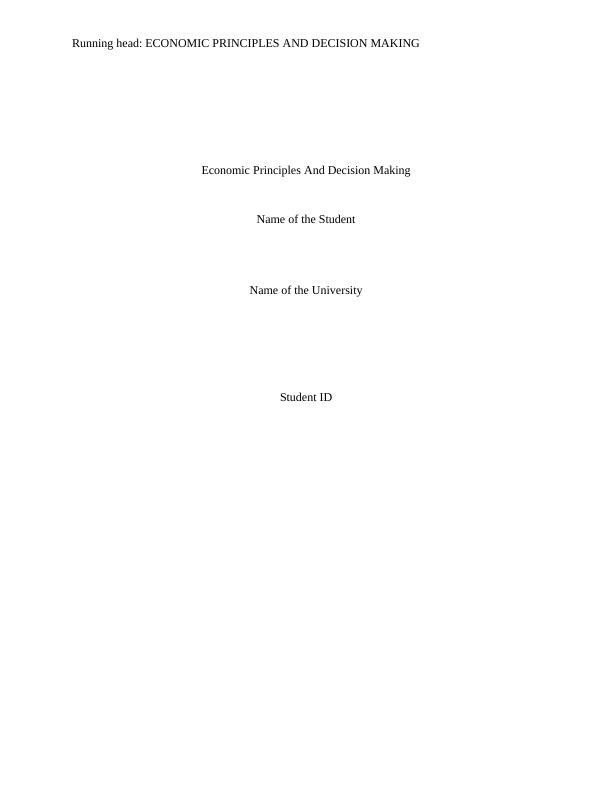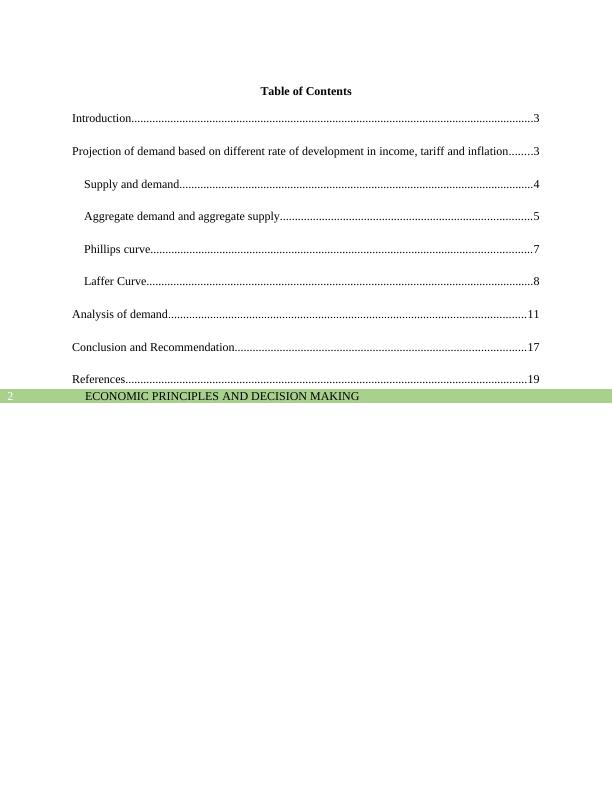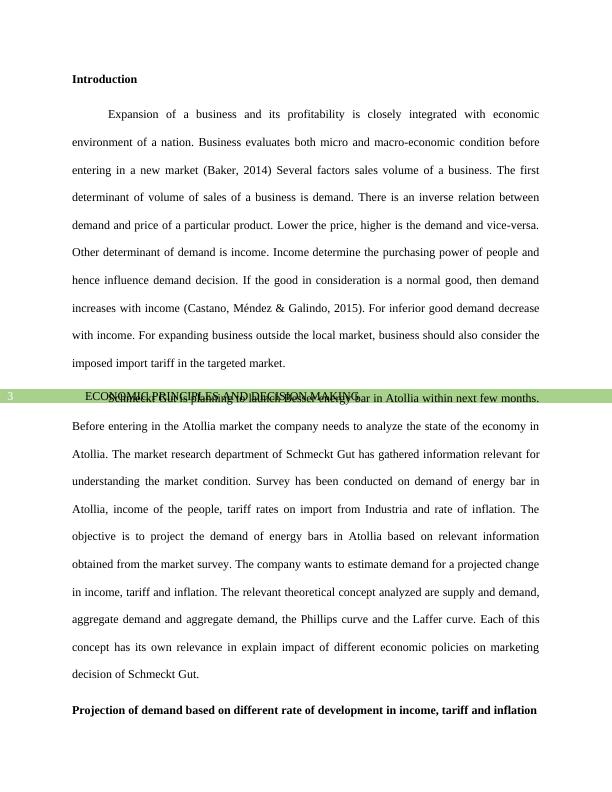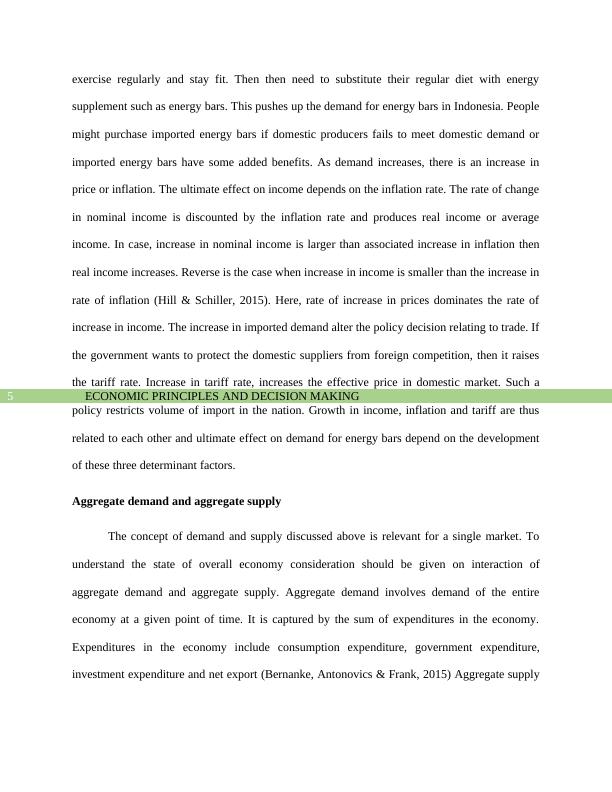ECON6000 Economic Principles and Decision Making
25 Pages4463 Words69 Views
Laureate International Universities
Economic Principles and Decision Making (ECON6000)
Added on 2021-12-15
ECON6000 Economic Principles and Decision Making
Laureate International Universities
Economic Principles and Decision Making (ECON6000)
Added on 2021-12-15
ShareRelated Documents
Running head: ECONOMIC PRINCIPLES AND DECISION MAKING
Economic Principles And Decision Making
Name of the Student
Name of the University
Student ID
Economic Principles And Decision Making
Name of the Student
Name of the University
Student ID

ECONOMIC PRINCIPLES AND DECISION MAKING1
Executive Summary
The research report aims to evaluate feasibility of introducing energy bar in the Atollia market.
market survey has been conducted to estimate demand of energy bar in the targeted market.
Demand projection is an important aspect in determining profitability of the business. A higher
local demand encourages firms to enter a market. The market survey on Atollai include four
main factors, income, tariff, inflation and number of gyms. The objective is to project demand
for energy bar for various level of changes in nominal income, tariff rate and inflation. The
economic concepts used for understanding business environment are supply and demand,
aggregate demand and aggregate supply, Philips curve and Laffer curve. The change in real
income is obtained after discounting the rate of change in nominal income by the rate of
inflation. The analysis finds that tariff has a significantly adverse effect on energy bar demand
while income has a positive significant impact on energy bar demand.
Executive Summary
The research report aims to evaluate feasibility of introducing energy bar in the Atollia market.
market survey has been conducted to estimate demand of energy bar in the targeted market.
Demand projection is an important aspect in determining profitability of the business. A higher
local demand encourages firms to enter a market. The market survey on Atollai include four
main factors, income, tariff, inflation and number of gyms. The objective is to project demand
for energy bar for various level of changes in nominal income, tariff rate and inflation. The
economic concepts used for understanding business environment are supply and demand,
aggregate demand and aggregate supply, Philips curve and Laffer curve. The change in real
income is obtained after discounting the rate of change in nominal income by the rate of
inflation. The analysis finds that tariff has a significantly adverse effect on energy bar demand
while income has a positive significant impact on energy bar demand.

ECONOMIC PRINCIPLES AND DECISION MAKING2
Table of Contents
Introduction......................................................................................................................................3
Projection of demand based on different rate of development in income, tariff and inflation........3
Supply and demand......................................................................................................................4
Aggregate demand and aggregate supply....................................................................................5
Phillips curve...............................................................................................................................7
Laffer Curve.................................................................................................................................8
Analysis of demand.......................................................................................................................11
Conclusion and Recommendation.................................................................................................17
References......................................................................................................................................19
Table of Contents
Introduction......................................................................................................................................3
Projection of demand based on different rate of development in income, tariff and inflation........3
Supply and demand......................................................................................................................4
Aggregate demand and aggregate supply....................................................................................5
Phillips curve...............................................................................................................................7
Laffer Curve.................................................................................................................................8
Analysis of demand.......................................................................................................................11
Conclusion and Recommendation.................................................................................................17
References......................................................................................................................................19

ECONOMIC PRINCIPLES AND DECISION MAKING3
Introduction
Expansion of a business and its profitability is closely integrated with economic
environment of a nation. Business evaluates both micro and macro-economic condition before
entering in a new market (Baker, 2014) Several factors sales volume of a business. The first
determinant of volume of sales of a business is demand. There is an inverse relation between
demand and price of a particular product. Lower the price, higher is the demand and vice-versa.
Other determinant of demand is income. Income determine the purchasing power of people and
hence influence demand decision. If the good in consideration is a normal good, then demand
increases with income (Castano, Méndez & Galindo, 2015). For inferior good demand decrease
with income. For expanding business outside the local market, business should also consider the
imposed import tariff in the targeted market.
Schmeckt Gut is planning to launch Besser energy bar in Atollia within next few months.
Before entering in the Atollia market the company needs to analyze the state of the economy in
Atollia. The market research department of Schmeckt Gut has gathered information relevant for
understanding the market condition. Survey has been conducted on demand of energy bar in
Atollia, income of the people, tariff rates on import from Industria and rate of inflation. The
objective is to project the demand of energy bars in Atollia based on relevant information
obtained from the market survey. The company wants to estimate demand for a projected change
in income, tariff and inflation. The relevant theoretical concept analyzed are supply and demand,
aggregate demand and aggregate demand, the Phillips curve and the Laffer curve. Each of this
concept has its own relevance in explain impact of different economic policies on marketing
decision of Schmeckt Gut.
Projection of demand based on different rate of development in income, tariff and inflation
Introduction
Expansion of a business and its profitability is closely integrated with economic
environment of a nation. Business evaluates both micro and macro-economic condition before
entering in a new market (Baker, 2014) Several factors sales volume of a business. The first
determinant of volume of sales of a business is demand. There is an inverse relation between
demand and price of a particular product. Lower the price, higher is the demand and vice-versa.
Other determinant of demand is income. Income determine the purchasing power of people and
hence influence demand decision. If the good in consideration is a normal good, then demand
increases with income (Castano, Méndez & Galindo, 2015). For inferior good demand decrease
with income. For expanding business outside the local market, business should also consider the
imposed import tariff in the targeted market.
Schmeckt Gut is planning to launch Besser energy bar in Atollia within next few months.
Before entering in the Atollia market the company needs to analyze the state of the economy in
Atollia. The market research department of Schmeckt Gut has gathered information relevant for
understanding the market condition. Survey has been conducted on demand of energy bar in
Atollia, income of the people, tariff rates on import from Industria and rate of inflation. The
objective is to project the demand of energy bars in Atollia based on relevant information
obtained from the market survey. The company wants to estimate demand for a projected change
in income, tariff and inflation. The relevant theoretical concept analyzed are supply and demand,
aggregate demand and aggregate demand, the Phillips curve and the Laffer curve. Each of this
concept has its own relevance in explain impact of different economic policies on marketing
decision of Schmeckt Gut.
Projection of demand based on different rate of development in income, tariff and inflation

ECONOMIC PRINCIPLES AND DECISION MAKING4
Supply and demand
Two important microeconomic concepts related to marketing decision is the demand and
supply. Demand explains the behavior of buyers where supply captures the behavior of sellers.
Demand is the willingness of buyers to purchase a particular good given the purchasing power.
Supply refers to the sellers’ willingness to supply a good at different prices. Optimal marketing
equilibrium is determined from the interaction of demand and supply forces. Any change in
demand or supply caused by factors other than own price affects leads the market towards a new
equilibrium position (Baumol & Blinder, 2015) Except price, factors affecting demand are
income, taste and preferences, price of substitute and complementary good. Income affects
demand through altering the purchasing power. Import tariff influences demand of imported
items by altering demand of importable in the domestic market.
Figure 1: Supply, Demand and market equilibrium
(Source: Sloman & Jones, 2017)
Increase in income likely to have a positive influence on demand of energy bars. As
demand increase, there is an increase in sales volume. The higher demand attracts both domestic
and foreign sellers in the market. With increase in income, people have a general tendency to
move towards a healthy life. As people becomes health conscious, they join gyms nearby to
Supply and demand
Two important microeconomic concepts related to marketing decision is the demand and
supply. Demand explains the behavior of buyers where supply captures the behavior of sellers.
Demand is the willingness of buyers to purchase a particular good given the purchasing power.
Supply refers to the sellers’ willingness to supply a good at different prices. Optimal marketing
equilibrium is determined from the interaction of demand and supply forces. Any change in
demand or supply caused by factors other than own price affects leads the market towards a new
equilibrium position (Baumol & Blinder, 2015) Except price, factors affecting demand are
income, taste and preferences, price of substitute and complementary good. Income affects
demand through altering the purchasing power. Import tariff influences demand of imported
items by altering demand of importable in the domestic market.
Figure 1: Supply, Demand and market equilibrium
(Source: Sloman & Jones, 2017)
Increase in income likely to have a positive influence on demand of energy bars. As
demand increase, there is an increase in sales volume. The higher demand attracts both domestic
and foreign sellers in the market. With increase in income, people have a general tendency to
move towards a healthy life. As people becomes health conscious, they join gyms nearby to

ECONOMIC PRINCIPLES AND DECISION MAKING5
exercise regularly and stay fit. Then then need to substitute their regular diet with energy
supplement such as energy bars. This pushes up the demand for energy bars in Indonesia. People
might purchase imported energy bars if domestic producers fails to meet domestic demand or
imported energy bars have some added benefits. As demand increases, there is an increase in
price or inflation. The ultimate effect on income depends on the inflation rate. The rate of change
in nominal income is discounted by the inflation rate and produces real income or average
income. In case, increase in nominal income is larger than associated increase in inflation then
real income increases. Reverse is the case when increase in income is smaller than the increase in
rate of inflation (Hill & Schiller, 2015). Here, rate of increase in prices dominates the rate of
increase in income. The increase in imported demand alter the policy decision relating to trade. If
the government wants to protect the domestic suppliers from foreign competition, then it raises
the tariff rate. Increase in tariff rate, increases the effective price in domestic market. Such a
policy restricts volume of import in the nation. Growth in income, inflation and tariff are thus
related to each other and ultimate effect on demand for energy bars depend on the development
of these three determinant factors.
Aggregate demand and aggregate supply
The concept of demand and supply discussed above is relevant for a single market. To
understand the state of overall economy consideration should be given on interaction of
aggregate demand and aggregate supply. Aggregate demand involves demand of the entire
economy at a given point of time. It is captured by the sum of expenditures in the economy.
Expenditures in the economy include consumption expenditure, government expenditure,
investment expenditure and net export (Bernanke, Antonovics & Frank, 2015) Aggregate supply
exercise regularly and stay fit. Then then need to substitute their regular diet with energy
supplement such as energy bars. This pushes up the demand for energy bars in Indonesia. People
might purchase imported energy bars if domestic producers fails to meet domestic demand or
imported energy bars have some added benefits. As demand increases, there is an increase in
price or inflation. The ultimate effect on income depends on the inflation rate. The rate of change
in nominal income is discounted by the inflation rate and produces real income or average
income. In case, increase in nominal income is larger than associated increase in inflation then
real income increases. Reverse is the case when increase in income is smaller than the increase in
rate of inflation (Hill & Schiller, 2015). Here, rate of increase in prices dominates the rate of
increase in income. The increase in imported demand alter the policy decision relating to trade. If
the government wants to protect the domestic suppliers from foreign competition, then it raises
the tariff rate. Increase in tariff rate, increases the effective price in domestic market. Such a
policy restricts volume of import in the nation. Growth in income, inflation and tariff are thus
related to each other and ultimate effect on demand for energy bars depend on the development
of these three determinant factors.
Aggregate demand and aggregate supply
The concept of demand and supply discussed above is relevant for a single market. To
understand the state of overall economy consideration should be given on interaction of
aggregate demand and aggregate supply. Aggregate demand involves demand of the entire
economy at a given point of time. It is captured by the sum of expenditures in the economy.
Expenditures in the economy include consumption expenditure, government expenditure,
investment expenditure and net export (Bernanke, Antonovics & Frank, 2015) Aggregate supply

End of preview
Want to access all the pages? Upload your documents or become a member.
Related Documents
Economic Principles and Decision Making - Doclg...
|16
|3156
|174
Economic Principles and Decision Makinglg...
|16
|4007
|132
ECON6001 - Economic Principles and Decision Making : Reportlg...
|16
|2797
|55
Economic Principles and Decision Making Assignmentlg...
|12
|2200
|359
Impact of Income Growth, Tariff Rate, and Inflation on Schmeckt Gut Demandlg...
|20
|4346
|31
ECON6000 Economic Principles & Decision Makinglg...
|20
|4617
|102
